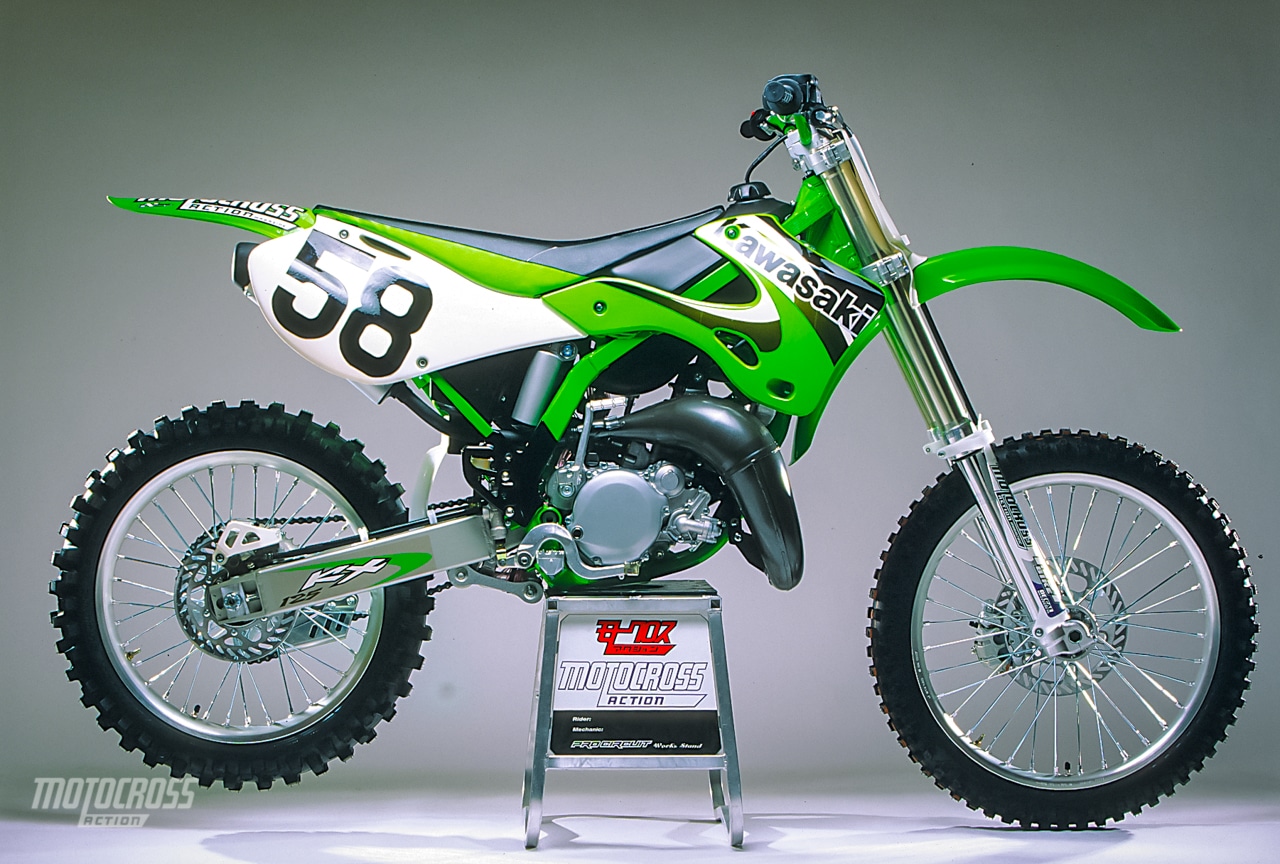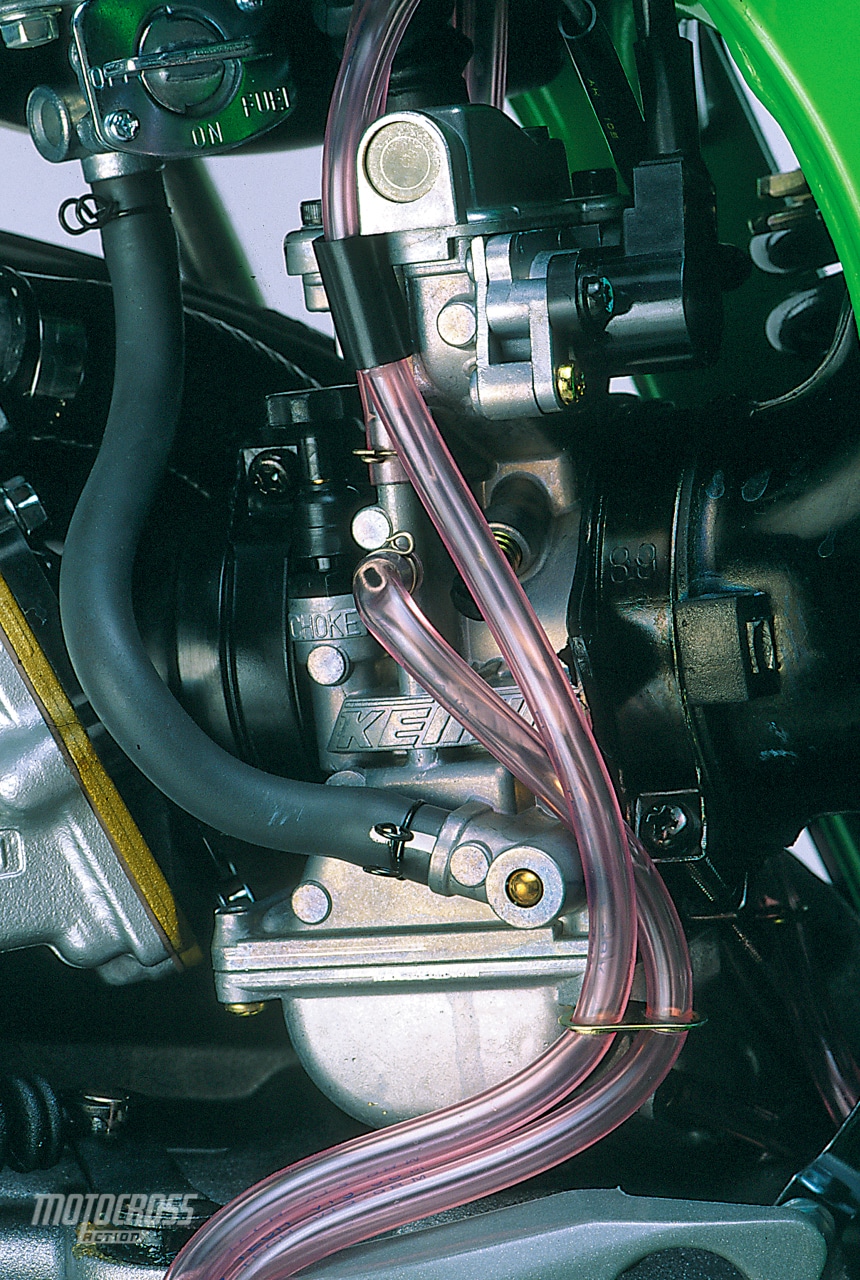ON THE RECORD: COMPLETE TEST OF THE 2000 KAWASAKI KX125
 This an archived test of the 2000 Kawasaki KX125 that was in the December 1999 issue of Motocross Action Magazine.
This an archived test of the 2000 Kawasaki KX125 that was in the December 1999 issue of Motocross Action Magazine.
QUESTION ONE: IS THE 2000 KX125 FAST?
Heavens no. Unfortunately, no. No.
QUESTION TWO: IS THE 2000 KX125 FASTER THAN THE ‘99?
What isn’t? Waring blenders, Black and Decker drills and Vegamatics put out more power than the ‘99 KX125. The sad thing is that Kawasaki has made major strides with the KX’s horsepower output. The ‘99 pumped out two more ponies than the ‘98 and the 2000 adds another horse to the mix–yet the bike is still anemic when compared to its competition
Is the 2000 faster than the ‘99 KX125? Yes, but most of Kawasaki’s powerband efforts were spent trying to give the KX125 a distinct powerband. For 2000, the KX engineers added more inertia to the drivetrain to help the KX125 churn out a broader powerband (hopefully adding some bottom and a little over-rev to what was a midrange-only engine). Unfortunately, it didn’t work as well as they hoped.
QUESTION THREE: IS THE 2000 KX125 ENGINE COMPETITIVE?
Let’s put it this way. If Team SplitFire’s Ricky Carmichael was forced to race a stock KX125 engine, he wouldn’t be a three-time 125 National Champion. True, a good rider could win races on this bike at the amateur level, but he’d have to work harder than the guy who finished second. In the pro ranks–forget about it (unless you ride for SplitFire).
QUESTION FOUR: WHAT ABOUT THE JETTING?
We had problems with the jetting of our KX125. Problems that would have forced us to bad mouth the stock set-up. But, in the midst of our testing, Kawasaki jump started their already completed test program and told us that they would make a “running change” to fix the jetting on all the bikes in the warehouse–and send out the proper jets to any buyer who already had a 2000 KX125.
It should be noted that Kawasaki’s last-minute jetting change is a “quick fix” and, over the long run, there will probably be a better jetting solution (most likely focusing on the slide cutaway). The KX engineers leaned out the Power Jet. Why? Because it was cost effective.
The major jetting changes will be in the pilot and Power jets (it is left to the rider to judge the size of the pilot jet for his local conditions).
QUESTION FIVE: WHAT JETTING DID WE RUN?
Here is what we ran in our bike for SoCal’s sea-level tracks:
Mainjet: 160
Pilot jet: 45
Power Jet: 42 (55 stock)
Needle: N7NW
Slide: 6.0
Air screw: 2 turns
Clip: 2nd (3rd stock)
QUESTION SIX: HOW GOOD IS THE GEARING?
This year the KX125 comes with a 49-tooth rear sprocket (last year it had a 48).
QUESTION SEVEN: WHAT ABOUT THE REAR SUSPENSION?
Kawasaki has decent rear suspension. They have a good shock, excellent valving and dual compression adjusters. The only thing they need to make the KX125 better is a straight-rate shock spring!
Kawasaki’s insistence on using a progressive-rate shock spring ruins the rear suspension. It allows the back end to wallow under acceleration, ride on the harsh part of the stroke under a load and bottom over the big stuff. Swap the stock shock spring for a straight-rate 4.9 kg/mm and you will love the rear of the KX125.
What was our best setting?
Spring rate: 4.9 (4.6-6.1 stock)
Race sag: 97mm
Hi compression: 1 1/2 turns out
Lo compression: 11 clicks out
Rebound: 13 clicks out
QUESTION EIGHT: HOW GOOD ARE THE NEW FORKS?
Let’s take this opportunity to explain how Kayaba’s new fork technology works. It should be noted that Kayaba calls the it SASS (Speed Activated Spring System), but everybody else just calls it the bladder fork.
(1) There are two air chambers; the traditional one above the oil level and a second one below the oil level (contained within a bladder).
(2) The two air chambers are divided by a special separator plate that sits on top of the cartridge cylinder.
(3) The separator plate is designed to leak oil. At slow fork shaft speeds, oil can leak around the separator plate’s Teflon seal quite easily. As fork speed increases, the Teflon band provides resistance to oil flow.
(4) At slow fork speeds, the two air chambers work in unison. The main air chamber and the air in the bladder compress at the same rate (controlled by displaced oil inside the cartridge and leaked oil from above being compressed).
(5) At higher fork speeds, the Teflon band restricts oil flow around the bladder, which allows the air in the bladder to be compressed at a slower rate than the air in the main chamber. The air in the main chamber compresses at a higher rate than the air in the bladder, thus leaving some additional air spring (which is what the compressed air acts as) to absorb higher loads.
(6) In essence, the two air chambers work as one unified air spring at slow fork speeds, but as two distinctly separate air springs (one with a high spring rate) at high fork speeds. The main air chamber is position-sensitive (to the height of the air in the chamber), while the air in the bladder is speed-sensitive (to the rate of resistance that the separator plate imposes on oil flow). This, in theory, allows a bladder fork to save air volume for emergency use.
QUESTION NINE: WHAT ARE THE BEST FORK SETTINGS?
What was our best setting? For hardcore racing we recommend this set-up:
Spring rate: 0.41kg/mm
Oil height: 110mm
Compression: 11 clicks out
Rebound: 13 clicks out
Fork leg height: 3mm above top of stanchion
Notes: Surprisingly, even though the new forks are bladder forks, which typically run a smaller primary air chamber, the 2000 KX125 has the same air volume as the ‘99 forks (in comparison, the 2000 KX250 forks have a much higher, 88mm oil height). Kawasaki did drop last year’s progressive-rate fork springs in favor of a stiffer straight-rate spring. Very good move.
QUESTION TEN: HOW DOES IT HANDLE?
The KX125 is the least 125-ish of all the tiddlers. The frame is big, wide and girthy. Its turning radius is not as razor sharp as most of its competition. It takes its time getting around a corner.
When sitting astride the KX125, you could swear you are aboard a KX250. It has the same ergos, but the numbers are not identical. The KX125 steering head is moved back 15mm, while the swingarm is shortened 10mm. This makes the little KX125 more agile than its big brother—although the sensation of roominess is hard to erase.
Do we think it is a great handling 125? No. But even though its not the quickest turning, most stable, lightest feeling or most petite–it still rates highly with the MXA wrecking crew because it feels more like a motocross bike than the other tiddlers. It doesn’t feel like a toy. It goes where you aim it and seems to absorb feedback better than your typical tiddler chassis. The KX125 has a much shorter wheelbase than the KX250, which eliminates the big KX’s reluctance to turn tight berms. Not every rider will fall in love with the big-bike feel of the KX125, but every MXA test rider did.
QUESTION 11: WHAT DID WE HATE?
The hate list:
(1) Decals: The new decals, which are only new if you carry a color chip chart around with you, chip away on day one.
(2) Gas tank: Mr. KX, please mold the gas tank in green plastic. It’s not as though you’re saving millions of dollars by making them all black The black gas tank makes it hard to see the fuel level.
(3) Bar clamps: We mounted a KX250 top triple clamp to our KX125. The KX125 comes with solid bar mounts, while the KX250 bar clamps are rubber mounted and reversible. We felt the need to move the bars forward in the clamps.
(4) Handlebars: The stock handlebars are prone to bending—and it doesn’t necessarily take a crash before they start flaking paint at the crossbar juncture.
(5) Shifting: It’s a little notchy.
(6) Clutch: The clutch is borderline, although it can take more abuse than the KX250 pack.
(7) The U-rims are nice looking, but we’ve seen enough cracked ones to wish for standard-issue hoops.
QUESTION 12: WHAT DID WE LIKE?
The like list:
(1) Pipe: The gray pipe coating is durable, non-rusting and trick looking.
(2) Air filter: The air filter locating system uses two prongs. We like this, but always reach in the airbox and make sure the bottom prong is in the hole.
(3) Seat brackets: Last year the seat brackets would break off. For 2000, Kawasaki replaced the pop rivets with threaded studs.
(4) Front brake lever: Kawasaki hasn’t totally solved their brake problems, but they do have a very ergonomic brake lever.
(5) Frame guards: Only Kawasaki and KTM offer plastic frame guards to keep the frame spars from scratching.
QUESTION 13: WHAT DO WE REALLY THINK?
It’s slow. Really slow. Slower than we thought possible (but we say the same thing about the KX125 every year). We think that the KX125 has the potential to be a great bike—but not with a boat anchor in place of an engine.











Comments are closed.